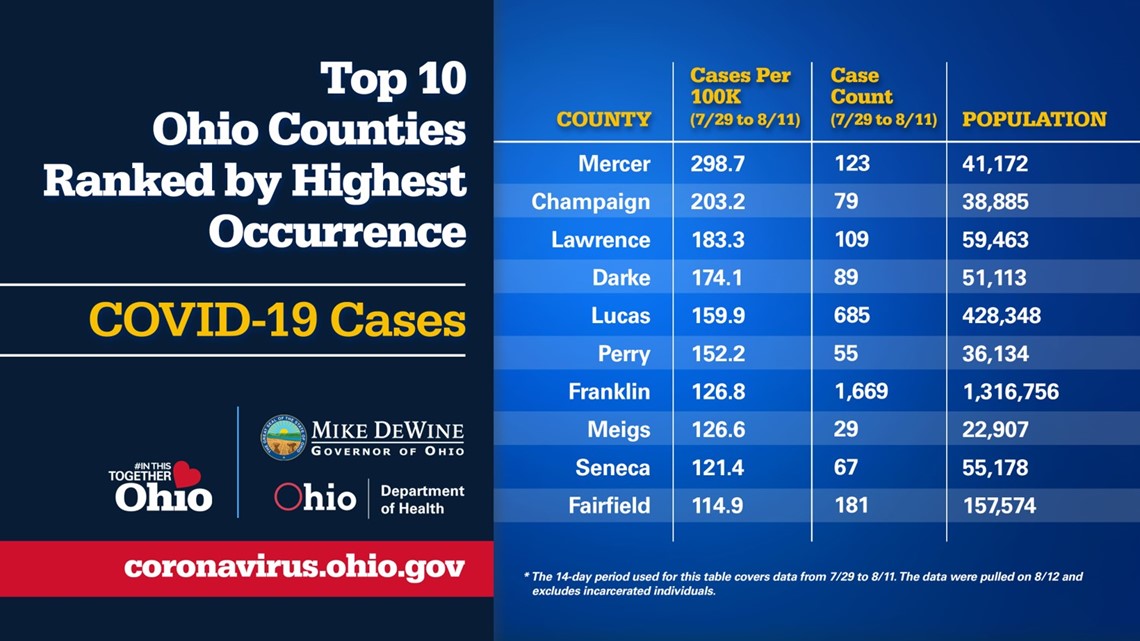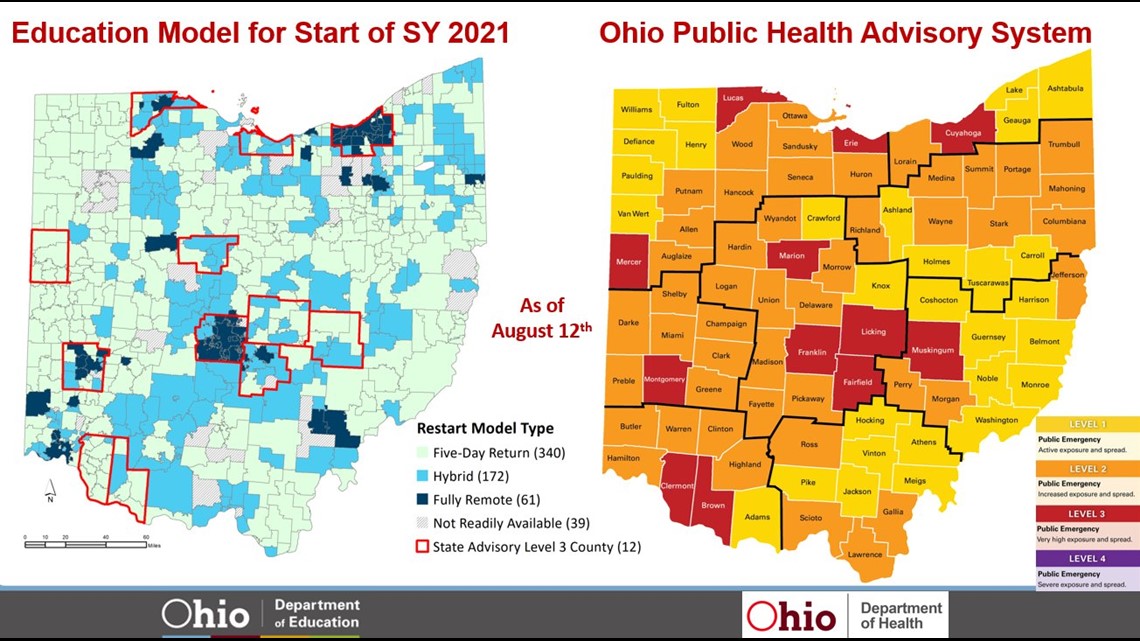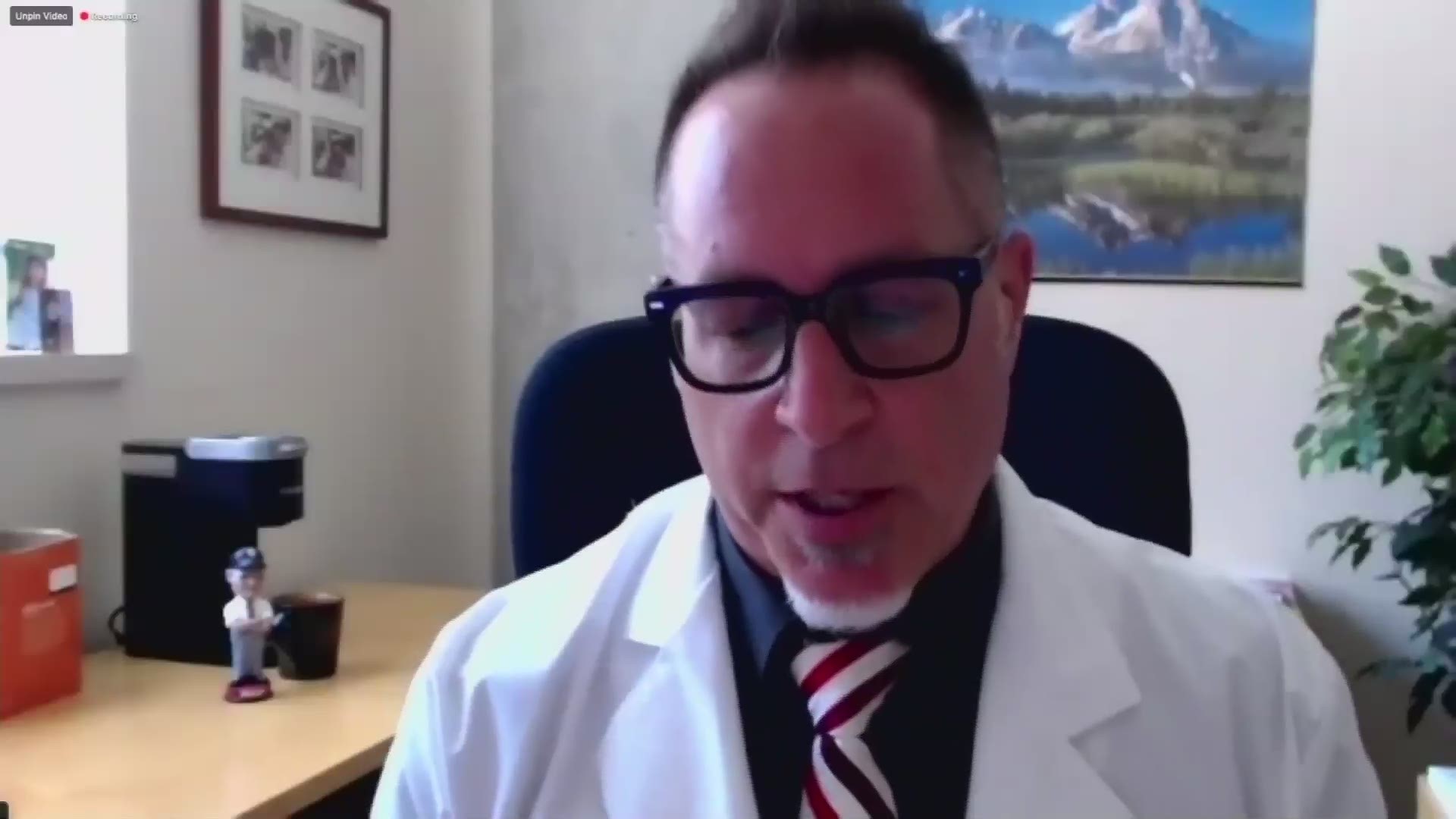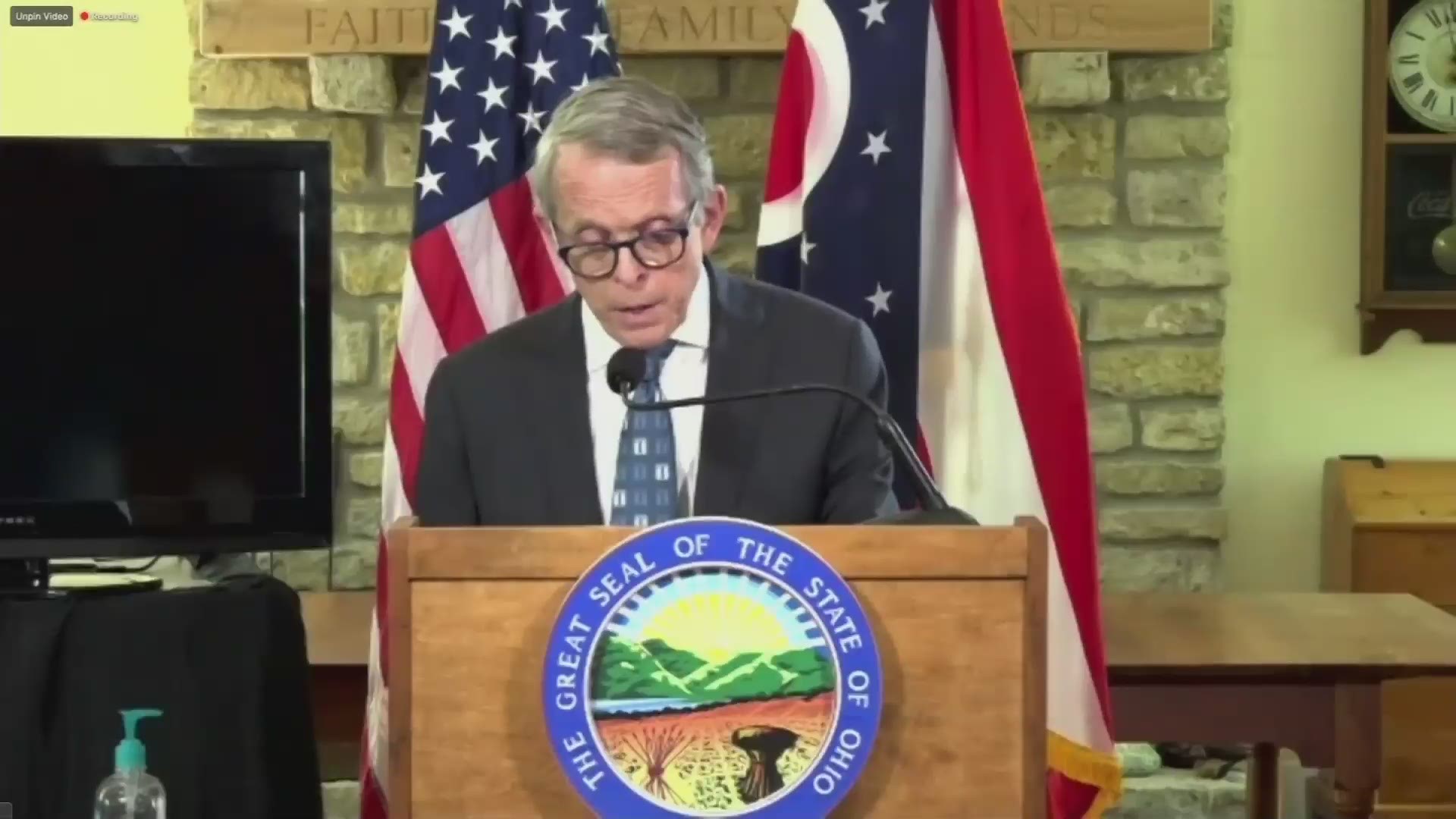COLUMBUS, Ohio — Governor Mike DeWine addressed Ohioans on Thursday from his home in Cedarville, with new information on the state's response to COVID-19.
Thursday's conference brought no announcement on sports, although the governor had initially promised new information in that realm last week. DeWine pushed any guidance on this front to his next press conference on Tuesday, August 18.
However, a large portion of Thursday's presser did focus on the potential health problems COVID-19 could bring to athletes or anyone who exercises with high intensity.
Here is a breakdown of what was discussed.
THURSDAY
CORONAVIRUS IMPACT ON THE HEART
DeWine explained that while he has talked for many months about the immediate health impacts of COVID-19, experts are now seeing a concerning issue in athletes.
The American Journal of Cardiology published an expert analysis last month that addresses the impact of coronavirus on the heart.
Ohio State has been routinely testing athletes as part of the university's protocol DeWine said.
The governor invited cardiologist Dr. Curt Daniels to discuss how coronavirus has been impacting athletes across the state.
Daniels said the concern as of late has been myocarditis being caused by coronavirus. While, there is a long history of myocarditis being brought on by viruses, this is especially being seen right now with COVID-19.
Most of the data that doctors have are from hospitalized patients, Daniels said. He explained that 20% of hospitalized coronavirus patients have been found to have cardiac involvement.
Daniels said that 10-13% of athletes his team tested, who also tested positive for coronavirus, were suffering from myocarditis as well.
The reason why athletic competition is being discussed so heavily, Daniels said, is because there is a risk with athletic competition and myocarditis. Having high, intense training may produce a higher level of arrhythmic burden; stressing the heart, especially if the heart is vulnerable with inflammation, brings the risk of a serious heart rhythm problem. So, it isn't just for athletes, anyone who takes part in strenuous exercise, participating in a Triathalon, etc., could be at risk.
When you do have viral symptoms at the early phase, Daniels said, it is very important to rest and not push yourself, until your virus is gone. If you ever develop shortness of breath, lightheadedness, palpitations, etc. you should get evaluated. Daniels suggested gradually increasing your exercise while you are in recovery, and if you develop any symptoms, again, you should be evaluated.
PUBLIC HEALTH ADVISORY MAP
DeWine updated his list of counties in order of those with the most cases per 100,000 people to those with the least. Lucas County had held the number two spot last week, but dropped to four on Tuesday and five on Thursday.
Seneca stayed as the only other local county in the top ten list, taking the ninth spot after previously being listed at 10 on Tuesday.


There are currently 12 counties in the Level 3 Red category on the state's Public Health Advisory map, including Lucas and Erie locally.
Erie is stuck in the red as it meets CDC threshold for high spread at 105 cases per 100,000 people. However that number is lower than it has been, so DeWine said the county is headed in the right direction. Lucas is also continuing to drop, with 159 cases per 100,000 people although, again, that is still well above the threshold. The CDC's definition of high spread is 100 cases per 100,0000 people.
The good news is, a number of counties, including Defiance, Fulton, Henry, Paulding and Williams locally, have dropped from orange down to yellow.
BACK TO SCHOOL MAP
DeWine again showed a map demonstrating what schools are planning to do for the start of the 2020-21 school year. This time, he put it side by side to the state's advisory map.
The governor said it will be a challenge in red counties where students are also going back in person. He called on each community to work together to slow the spread of the virus, to make sure kids are able to stay in school.


KEY INDICATORS
Between Wednesday and Thursday, there were 1,178 new cases of coronavirus reported in the state. That's just below the 21-day average of 1,202.
In that same time frame, there were 21 deaths, compared to the 21-day average of 24.
Both hospitalizations and ICU admissions do remain above average, however.
On Thursday there were 122 hospitalizations and 22 ICU admissions reported, with the averages coming in at 98 and 16 respectively.
MINORITY HEALTH
On Thursday, DeWine said his team would be releasing the Minority Health Strike Force's final report. It has 34 recommendations on dismantling racism, removing public health obstacles, improving the social/economic and physical environments, and strengthening data collection to better track disparities.
In response to this report, DeWine said he would be issuing “Ohio’s Executive Response: A Plan of Action to Advance Equity," the governor's action plan to reinforce his administration's commitment to advancing health equity and establishing Ohio as a model for justice, equity, opportunity, and resilience.
DeWine challenged the state's colleges and universities to come up with ways to recruit more African Americans and other minorities to become teachers. He also called on the Ohio Department of Job and Family Services to do more with foster care and focus on ways to get more minorities into the realm business.
While Ohio is a popular place for innovators and entrepreneurs, Lt. Governor Jon Husted said that in the minority community, potential businessmen and women have struggled to get a foothold.
The governor challenged the state's health department to address this issue of lead paint.
"It's terrible that in 2020 we still have children poisoned by lead paint," he said in a tweet.
DeWine also made note that his team has laid before the General Assembly a comprehensive plan to achieve equality in policing. On Thursday, he asked them to pass it.
In regard to more equality in policing, we have laid before the General Assembly a comprehensive plan to achieve this. Today, I am asking them to pass it.
"Racism is a public health crisis. This is something we have to work on every day," DeWine said, "It really goes back to what I said when I was sworn in as governor, and that simply is our dream should be that every child in Ohio, wherever they live, whatever their background, whatever their race, they should have the chance to live the American dream and we need to do whatever we can to give them that chance."
One of DeWine's new commitments on Thursday was the creation of the Ohio Governor's Equity Advisory Board. This is a permanent, ongoing group to help guide state leaders as they work to address the underlying conditions and root causes contributing to disparities in life and health in Ohio.
SPORTS
After initially promising an announcement this week, DeWine pushed that to Tuesday of next.
While little was said, the governor did mention that should sports move forward in the fall, attendance would be limited.
He reiterated the fact that what goes on in the school, what goes on with the athletes, is impacted by what goes on in the community.
"We all just need to be in this together. We all want our kids to have this experience, but it won't last... it won't last unless we can slow this thing down," DeWine said.
NURSING HOMES
DeWine said that his team has started on a new program of testing, which requires every nursing home to do its own testing every two weeks, with the hope of eventually doing it every seven days.
The National Guard can now focus on logistics, meaning they take the swabs from the nursing homes to the labs.
DeWine clarified that a nursing home could be doing everything right, and still have an outbreak. He believes the best course of action is to increase testing and tracing in these facilities.
ASL TRANSLATION
TUESDAY
SCHOOLS
DeWine noted on Tuesday that the number of cases in Ohio's youngest population is on the rise.
Back in March, the percentage of Ohio's cases that were in the 0-19 range was just 2.4%. However, in August, that number jumped up to 12.8%.
DeWine also released a map demonstrating the breakdown of how public schools are approaching the upcoming school year: in-person return (yellow), fully remote learning (blue) or a hybrid model (green).
Here is a breakdown of what we know:
- The state has 325 districts that plan to return full-time. That’s about 590,000 public school students or 38%.
- Ohio has 55 districts or about 25.6% (approximately 398,000 students) of public school students that will be fully remote or online.
- There are 154 districts or 24.5% (approximately 380,000 students) will be doing some form of hybrid schooling.
- There are 78 districts for which there is not information readily available.
DeWine made clear that he believes if we want kids to be in school and if we want them to be able to participate in extracurriculars, it's incumbent on all Ohioans to take the right steps to reduce the spread of the virus. This includes wearing a mask, avoiding large gatherings and just being careful overall.
CORONAVIRUS AND CHILDREN
Three Ohio doctors joined Tuesday's conference to help explain different aspects of how the virus impacts children and those around them.
DR. JOHN BARNARD - NATIONWIDE CHILDREN'S HOSPITAL
Dr. John Barnard joined in on Tuesday's conference to break down what health leaders understand at this point about how the virus impacts children.
He made clear that children do get COVID-19, and not infrequently. However, they are much less likely to have serious complications and many don't even display symptoms.
However, this isn't the case for all the children. Barnard said his that out of all the cases in children his team has encountered across the state, 8% have required a stay in the hospital with about 1% going to the ICU. Some of these cases do occur in children with pre-existing conditions, he said, including obesity, diabetes, etc.
However, on a positive note, as of 7 a.m. Tuesday, none of the Nationwide's children's hospitals had any youth in the ICU.
Barnard also noted that minority children are 4-6 times more likely to develop complications or be hospitalized due to COVID-19.
Older teens are also more likely to test positive, which could be attributed to their likelihood to get out into the community, especially since those who are 16-19 are starting to drive on their own.
PATTY MANNING - CINCINNATI CHILDREN'S HOSPITAL
Dr. Patty Manning also joined the conference, focusing on how children spread the virus to those around them.
Younger children, who require more care, may spread the virus easily, especially those who are asymptomatic. Those who are very young may require more close contact.
However, teens also run a high risk of spread, as they are more likely to go out and meet up with groups of friends.
Manning explained several factors that are important for those students who are returning to in-person learning:
- Wearing masks
- Maintaining distancing; while six feet is the best, three feet is good and four feet is better.
- Hand hygiene; washing hands frequently
- Surface cleaning
- Ventilation; teachers should open windows, or conduct class outside when possible
Manning said that it is OK to be uncertain. She suggested talking with children about what to expect.
DR. ADAM MEZOFF - DAYTON CHILDREN'S HOSPITAL
Dr. Adam Mezoff with Dayton Children's Hospital explained that his team has been working with school officials and primary care physicians to help put together a back-to-school guide.
The guide starts with the question, "In the last 14 days, have you been in contact with someone who has tested positive for COVID-19?" If the answer is yes, the next prompt asks if the reader was within six feet for longer than 15 minutes. Mezoff said the CDC defines this qualifier as "significant exposure."
Mezoff also reminded Ohioans that not all the illnesses that will be seen at schools this year will be COVID-19. However, regardless of the illness, anyone who is sick should make sure to stay home.
The guide his team put together also runs though potential scenarios and explains how schools and parents should respond.
KEY METRICS
There were 1,095 new cases of coronavirus reported on Tuesday, below the 21-day average of 1,220.
However, coronavirus-related deaths, hospitalizations and ICU admissions were all above the average. Although, this could be due to a lag in reporting from over the weekend.
On Tuesday, there were 35 new coronavirus-related deaths, compared to the average of 23. There were also 135 new hospitalizations and 19 new ICU admissions. The 21-day average for those metrics is 96 and 16 respectively.
COUNTY CASES PER 100,000
DeWine released an updated list ranking all 88 counties in order of those with the most cases per 100,000 people to the least.
Lucas County had been in the number two spot for a week but has since dropped down to number four.
Locally, the only other county in the top 10 was Seneca. DeWine explained that outbreaks were traced back to a flea market, weddings and long-term care facilities However, the governor said more information on this will be made available at Thursday's conference.


